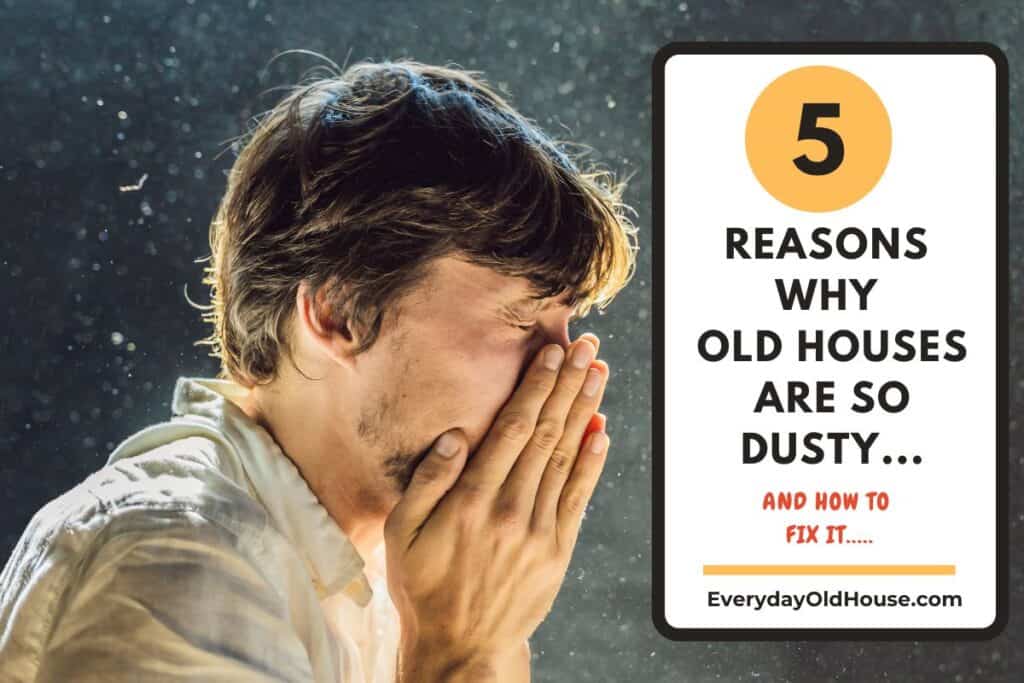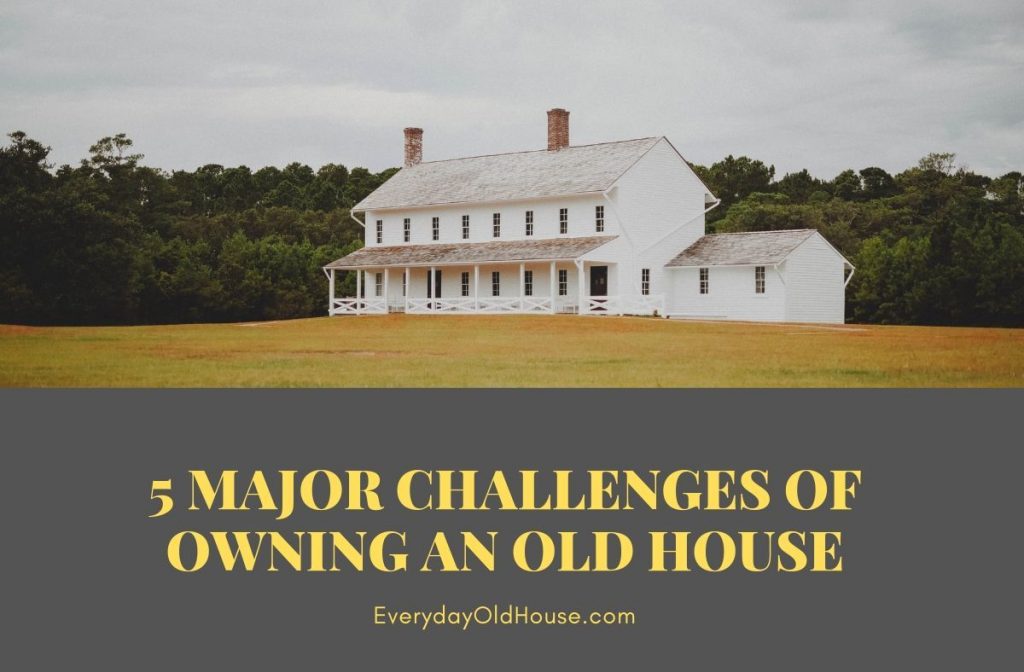Last Updated on March 18, 2024
Old houses possess a quant character and charm that few newly built homes can match. But old houses certainly have their challenges – additional maintenance, increased fire risk, musty smells, and…..drum roll please….dustier than new builds. Here’s 5 reasons why old houses are dustier AND more importantly, how to fix it.

What is Dust?
First, let’s talk about dust itself. It’s that pesky stuff that seems to accumulate everywhere no matter how often you clean. Right?
Right.
BUT you might want to educate yourself a bit more about what dust and where it comes from so that you can fully tackle and rid your old home of it…..
Dust is a hodgepodge of tiny particles that build up in the air and settle on your furniture, curtains, light fixtures and floor. These particles come from a wide range of sources, such as:
- Dirt/soil
- Pollen
- Hair
- Flaking skin cells (yuck!)
- Pet dander
- Fibers
- Food particles
- Mold spores
- Bacteria
- Viruses
- Smoke
- Dust mites
- Pests (body parts and waste – again, yuck)
Let’s continue (but strap in, this is going to get gross….)
Where Does Dust Come From?
Dust is generated by sources both inside and outside your home. It’s been calculated that about 60% of dust inside your home originates from the outside. These dust particles are tracked in through the soles of your shoes (or pet’s paws), or through windows, doors and vents (which you will find out are MAJOR sources of old house being so dusty.
The other 30% is generated from interior sources, most of it from occupant habits, such as smoke, food particles, and yes, even your shedding skin. (I warned you it was going to get gross!)
Health Effects of Dust
Dust not only makes your house unpleasant and unclean; it also can adversely affect you and your family’s health.
Dust particles are made up of a variety of sizes. When inhaled, larger dust particles are usually trapped in your nose and aren’t a huge concern from a health perspective. However smaller dust particles can infiltrate into your lungs and, in sufficient quantity, cause health problems.
In dusty homes, the average healthy person will experience a stuffy nose, itchy eyes, and sneezing. But for those with existing respiratory conditions, dust can exacerbate symptoms. For example, asthmatics may experience increased trouble beathing, wheezing, and chest tightness.
In addition, research has also found that dust contains various amounts of contaminants, like arsenic, lead and DDT, which are linked to various health conditions, including cancer.
5 Reasons Why Old Houses Are Dustier
Dust is a problem in every house. However, old houses are dusty than new probably because of these 5 additional factors.
1. Leaky Windows and Doors
It’s no secret that older homes tend to have more gaps and cracks in its exterior, especially with aged windows and doors. Over the years, windows and doors endure harsh conditions that can result in significant wear and tear, such as:
- Hinges wear out, making panels misalign
- Repeated heat and cold weather triggers expansion and contraction of wood
- Deteriorated weather-stripping that isn’t replaced
And that leads to a drafty, uncomfortable and energy inefficient home.
Have you even considered that the drafts coming into you home isn’t just air? That dust, pollen, and other particles are also blowing right into your old house?
Solution
While some may recommend replacing windows and doors, I’m not that girl. In my humble opinion, original windows and doors are an essential component of those unique charming features you find in old houses. And replacing should be a last option.
There are some easy (and cheaper than replacement costs) to keep dust from blowing inside AND increase energy efficiency (bonus points of lower energy bills!) such as:
- Apply caulk to gaps around windows
- Replace worn weather-stripping around doors
2. Outdated HVAC Systems
In the simplest of terms, HVAC systems warm in the winter, cool in the summer, and ventilates year-round. Some HVAC units even can improve the air by drawing it through filters that remove dust, particles, spores, bacteria, and viruses.
But if you have an outdated HVAC system, you might be contributing to increased dust accumulating and circulating in your old house.
Like all aging major appliances, older HVAC systems experience usual wear and tear. Over the years holes develop in the ductwork running throughout the house, or the seals between part connections are compromised.
Not only do old HVAC parts accumulate dust, the habits of your home’s previous homeowners can contribute to why old houses are dustier. Perhaps these homeowners didn’t maintain the system adequately – no annual cleaning, never changed filters, used cheap filters, etc…
If you want to be grossed out, check out this YouTube video of a professional removing decades of dust that have accumulated in ductwork in a house.
Solution
You best bet is to call in a professional to conduct a thorough check on your old HVAC system, especially the ductwork. Have the ductwork cleaned and pressured tested to detect leaks (and repair if necessary).
If your HVAC system has exceeded its lifespan, it might be time to replace. The Department of Energy recommends replacing your HVAC about every 15-20 years (although that doesn’t seem like a long period of time, does it?)
Newer HVAC systems come equipped with high-efficiency filters that capture tiny particles that old system miss, reducing your exposure to dust in your old house. Plus, newer HVACs can reduce moisture in your home, which can reduce dust mites (more on them later….).
3. Old Carpet
When you bought your old house, did it have wall-to-wall carpet? If so, I’m come bearing bad news. You might be holding onto decades of dust, creating a reason why old houses are dustier.
Carpet fibers hold onto dust, whether it be dust tracked in from dirt on your shoes (or pet’s paws) or particles that have settled from the air.
Over time, dust particles get pressed down further and further into the carpet and get stuck into the deepest layers of carpet fibers.
Bottom line – the older your carpet, the more dust it holds.
To add insult to injury, as a carpet ages, carpet fibers break off and become a source of dust! UGH.
What are Dust Mites?
Oh, and do you know who loves to live in dust in carpets? Dust mites. Yup, we are going there….
According to the American Lung Association, dust mites are very small, insect-like pests that feed on dead human skin cells and thrive in warm, humid settings. They live in a variety of places in your home, including, you guessed it, carpets.
Research has shown dust mite concentrations are 6-14 times HIGHER in carpeted homes than smooth floors. And where were the highest concentrations? Yup, the oldest houses…
Solution
The most effective way to eliminate dust (and dust mites) snugly settled in your carpet is to completely remove the carpet and restore the floor underneath (or install new).
Admittedly in old houses, who knows what you might find under that old dingy carpet. Perhaps you will find beautiful hardwood floors dying to be polished and shown off. Or perhaps a nightmare vinyl floor so beat-up that it should never, ever see the light of day again.
But don’t you agree taking that risk is better than thinking about all those dust mites happily hiding in your carpet??
But if you must keep that carpet, be sure to check out the here’s a few suggestions:
- Frequently deep cleaning (at least 2 times a year)
- Run a humidifier dehumidifier to avoid feeding dust mites.
In addition, if your carpet has a funky smell, check out these 10 Ways to Remove Old Smells from Carpets.
4. Pest Infestations
This one is kind of gross, but we need to talk about it. Research has shown that older houses are more susceptible to termite damage. Termites and other wood-boring insects love to take up residence in older houses because they tend to have the best food (i.e. untreated wood), best humidity (i.e. high moisture from leaks) and easiest way to travel up from the soil (i.e. foundation issues).
Termites attack anything wooden – floors, cabinets, even furniture if not caught in time. And they leave behind excrement (apparently called termite frass) that looks like sawdust.
And that “sawdust” can get kicked up into the air for you to breathe.
Yeah. A yucky reason why old houses are dustier than new builds.
Solution
If you think you have termites (and seen signs such as buckling ceilings or walls, or termites themselves), then the best step is to have a professional termite inspector assess and treat. Once ensuring your home is pest-free, then existing damage should be repaired.
However, if you don’t have termites, here’s a few simple tips to protect your home and avoid infestations, such as:
- Eliminate wood directly contacting the ground
- Stop moisture from accumulating near the foundation
- Reduce moisture and humidity in crawl spaces
- Store firewood away from house
- Use mulch carefully
5. Deteriorating Building Materials
Over time, some building materials used in older homes can break down and deteriorate, releasing dust and particles inside the home. Here’s a few examples of building materials prone to breaking down and releasing particles, making old houses dustier:
- Insulation
- Plaster
- Paint
- Ceiling panels
Solution
Your best bet in keeping up with deteriorating building materials in your home is simply being diligent and keeping up with home maintenance. Ensure that cracked plaster is fixed, sagging ceiling tiles are repaired, chipped paint gets a fresh coat, etc.
Related Posts
Want to be the first to know about new posts? Be sure to follow me on Pinterest, Facebook, Instagram or Twitter of even Etsy! Or better yet… Subscribe below!
My monthly (admittedly sometimes more, sometimes less….) emails are like receiving a unexpected letter from an old friend WITHOUT needing to put on your slippers and walk out to your mailbox…. See? I got ya, my friend!)
[Note: My posts are proudly connected to these amazing link parties full of DIY ideas and inspiration!]

